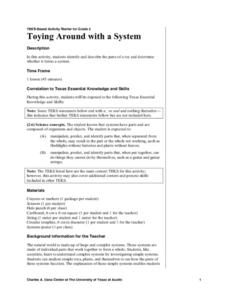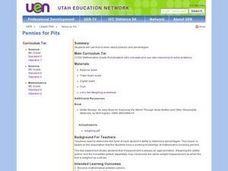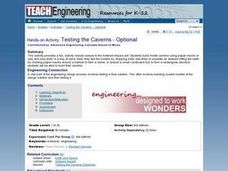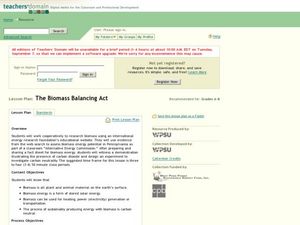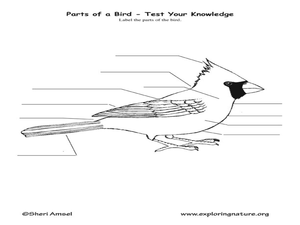Curated OER
Toying Around with a System
Second graders look at the system that could be present in common toys. They manipulate and identify parts that have to work together in order to form a system. When working or not students should comprehend how things go together.
Curated OER
Animals Piece by Piece
Learners sort organisms and objects into groups according to their parts and describe how the groups are formed.They identify body parts of animals from puzzle pieces, assemble the puzzle, and name the animal.
Curated OER
Mythical Animals
Students create imaginary animals by assembling pictures of body parts from pictures of real animals. This is one of three linked tasks. The others are "Who's Parts Do I Have?" and "Animals Piece by Piece."
Curated OER
Dog Salmon
Students study the life cycle of the Dog Salmon while practicing naming the outside parts of the salmon in both English and Athabascan. They record observations in journals.
Curated OER
Animals, Piece by Piece
Students receive teacher prepared puzzles of animals. They try to name the animal by looking at only one piece. Students work in groups to assemble the puzzle pieces and name the animal. They draw their own pictures of the animals in...
Curated OER
Insect Safari
Third graders name and identify three body parts of an insect, identify the characteristics that insects have six legs and one pair of antennae and categorize insects as to whether they are helpful or harmful.
Curated OER
Identifying trophic levels and the skeletal system through Owl Pellets
Students identify a food chain sequence. They compare, identify, and record the rodent skeletal parts to a rodent skeletal diagram. Students construct a rodent skeleton from the skeletal parts found in the pellet. They are given the...
Curated OER
Pennies for Pits
Sixth graders use the edible and nonedible parts of various fruits to determine percentages. Using measurements and appropriate tools are part of the instructional activity.
Curated OER
The Numbers Game
Learners examine how to calculate the part-per-million and part-per-billion units used to measure contaminant concentrations in the environment. They calculate ratios, take a quiz, analyze a sample chemical spill, and determine if...
Curated OER
Cow's Eye Dissection
Pupils identify the parts and function of the different parts of the eye. In this anatomy lesson, students simulate dissection using Exploratorium website. They watch a video and write the procedure of cow's eye dissection.
Curated OER
Cookie Paleontologists
Students become cookie paleontologists. In this paleontology lesson, students try to excavate whole chocolate chips from a chocolate chip cookie without breaking the cookie. They use toothpicks and paintbrushes to do it.
Curated OER
TE Activity: Testing the Caverns
Students make model caverns out of paper mache or clay. They bury them in a tray of sand, and test the models by dropping balls into them simulating as asteroid hitting the earth. They discuss the results of the activity in a whole class...
Curated OER
The Biomass Balancing Act
Students work in groups to research biomass using the International Energy Agency's website. Students use evidence from the web search to assess biomass energy potential in Pennsylvania as part of a classroom "Alternative Energy...
Curated OER
Examples for Socratic Questioning: Climate And Solar Radiation
High schoolers explore the various controls on the amount of solar radiation received at different parts of the Earth's surface by participating in a whole class discussion. They respond to prompts that lead them to conclusions about ...
Curated OER
Mystery of the Senses-Touch
Students test the skin's range of sensitivity. Students complete a "Touch Areas" activity. They discuss their results with the class. Students make conclusions about which parts of the body are most sensitive to touch.
Curated OER
Dog Salmon Lesson Three
Learners observe patterns and scale sizes on the salmon skin. They explore the tanning of salmon skills and practice the Athabascan terms for the salmon parts. They make salmon skin prints.
Curated OER
Are You Sure it is not the Distance?
Students examine how the changing distance between the Earth and the sun causes the seasons. They watch a Science Court video, and answer discussion questions using Science Court Seasons software.
Curated OER
Weather Watchers
Students engage in this weather predicting lesson. They discover instrumentation used in the meteorological science. With this knowledge, they will create their own "low-tech" versions of weather instrumentation such as thermometers,...
Curated OER
Animal Top Trumps
Second graders evaluate different animals. In this animal parts lesson plan, 2nd graders create a game that compares animals based on five concepts- attack, defend, agility, speed and size.
Curated OER
Draw your Conclusions
Students analyze data from a student discussion website and write a report on the outcome of an investigation regarding their local water quality. As part of a larger unit students then post the summary of their investigation on the...
Curated OER
Boundaries
Students identify and analyze the boundaries which exist between urban and rural, wildness and country and among rural areas, country, town, and city. Students actively participate in planning, obtaining materials, setting goals and...
Curated OER
Learning Bird Traits
Students draw and label a bird. In this bird traits lesson, students learn what traits make a bird different from other animals. Students are taught how to draw a bird and are expected to label the various body parts they drew.
Curated OER
Gases Around Us
Learners participate in a whole class discussion about solids, liquids, and gases. Students get involved in a teacher-directed experiment related to solids, liquids, and gases. Learners complete worksheet, writing the names of the parts...
Curated OER
Air Quality Issues
Students study and chart the levels of the atmosphere. They determine volume and location of the whole in the ozone layer by problem solving and drawing Antarctica.
